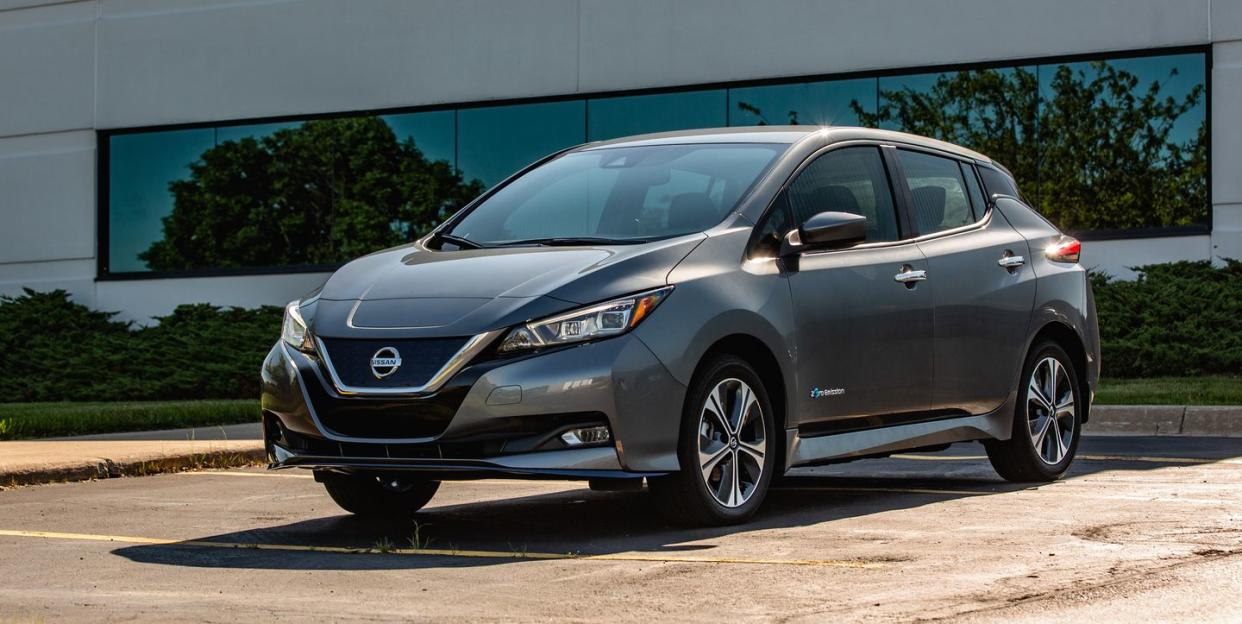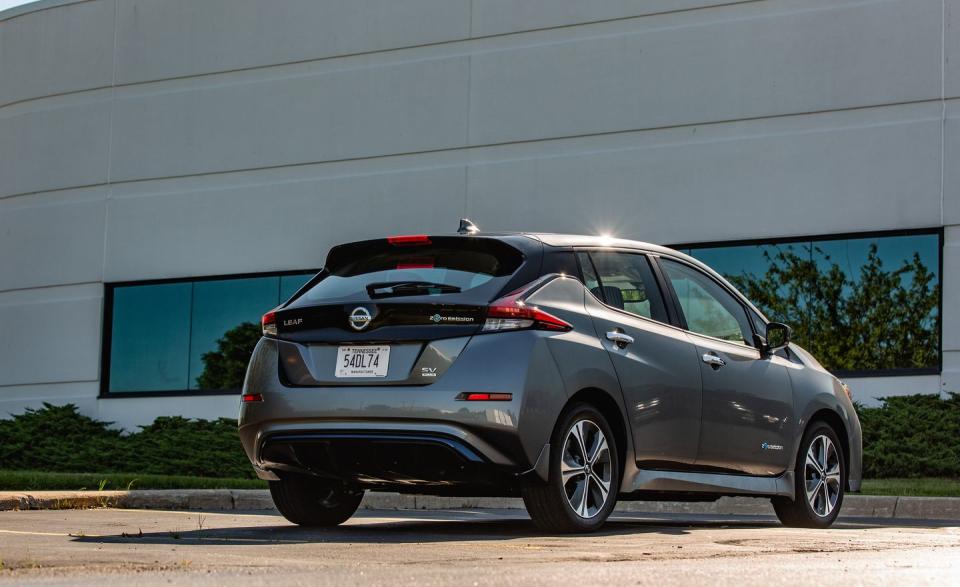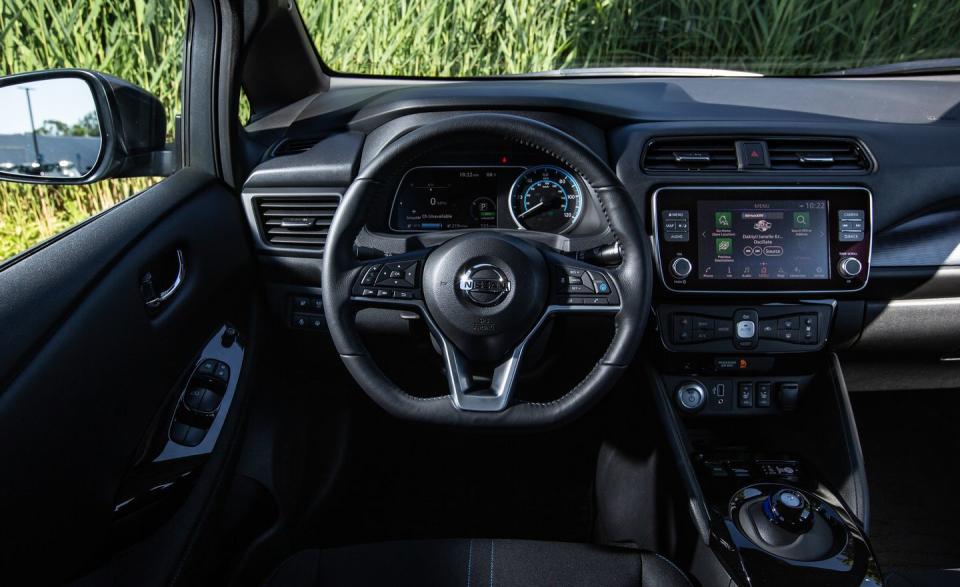Electric 2019 Nissan Leaf Plus Is the Better Leaf We've Been Waiting For

This review has been updated with test results.
Two hundred miles is a paltry range for a vehicle powered by an internal-combustion engine. But for those eyeing an EV as an affordable, low-hassle transportation choice, that distance has quickly become the de facto minimum for those looking to buck convention with an electric vehicle. While it's taken some time for Nissan's Leaf to reach that mark (it debuted for 2011 offering just 73 miles of EPA-estimated range), the new-for-2019 Leaf Plus not only gains access to the 200-mile club but brings additional power and features along for the ride.
On sale now alongside the 40.0-kWh Leaf, the 62.0-kWh Leaf Plus delivers an EPA-estimated 215 miles of range, up from the standard hatchback's 150 miles. The additional capacity also brings the Leaf closer to the 64.0-kWh capacity of both the Hyundai Kona Electric and the Kia Niro EV and exceeds that of the 60.0-kWh Chevrolet Bolt EV. The key is its floor-mounted battery, which, through advancements in manufacturing, houses its greater energy in roughly the same space as the lower-capacity Leaf's battery. The air-cooled pack hangs a bit lower than the standard car's, necessitating a 0.4-inch increase in ride height, yet a generous 24 cubic feet of space remains behind the Leaf's rear seat.

Powering Up
The Leaf Plus also benefits from a recalibrated electric motor, which generates 215 horsepower, up from 147 in the regular model. With 251 lb-ft of torque on tap, there's a healthier, immediate shove available off the line and during passing maneuvers, allowing the Nissan to squirt more effectively through gaps in traffic. Despite carrying an additional 337 pounds versus the last Leaf we tested, the Plus can sprint from zero to 60 mph in a decent 6.8 seconds, an improvement of 0.6 second. A 190-foot stop from 70 mph is about the same as before and 0.76 g around the skidpad represents a slight drop in lateral grip. But the Plus can achieve a governed top speed of 106 mph, up from our previous test car's 92-mph terminal velocity.
Over an indicated 109 miles of congested city and highway driving in temperate Southern California weather, the Plus's computer dropped its range by 106 miles, making the EPA's 215-mile estimate seem realistic under optimal conditions. Back in Michigan under similarly temperate conditions, the Plus averaged 90 MPGe while in our care and returned 180 miles of highway range at a steady 75 mph, placing the updated Leaf's key figures right in the hunt with those we've recorded for the Bolt, Kona, and Niro EVs.
The Leaf's driver-selectable regenerative-braking system, e-Pedal in Nissan-speak, has been retuned to account for the extra mass and power, and it can bring the Plus to a full stop without touching the brake pedal. The deceleration effect is linear and stronger than before, and the normal friction brakes blend in smoothly when stopping quickly. Despite revisions to its suspension and chassis systems to compensate for its additional weight, the Plus drives with the same comfortable ride quality, decent body control, and lazy steering that make its lesser brother an easygoing partner around town. As with the standard Leaf, the cabin is nicely hushed at speed, with minimal intrusions from road and wind noise. We measured only 69 decibels of noise inside at a 70-mph cruise.

Additional Perks
Exterior touches include a small Plus badge on the rear hatch and subtle blue accents on the lower edges of the bumpers. The interior carries over from the 40.0-kWh Leaf, yet Nissan provides more standard equipment to the Plus's S, SV, and SL trim levels, including forward-collision warning, an intuitive 8.0-inch touchscreen infotainment system, and a Level 1 and 2 charging cable. Despite increasing battery capacity and motor power, Nissan didn't upsize the Leaf's 6.6-kW onboard charger for Plus duty. Replenishing the larger battery requires 11.5 hours with a Level 2 connection versus 7.5 hours for the 40.0-kWh model. The Plus, however, can source electrons from a more powerful 100.0-kW DC quick charger (the non-Plus Leaf is limited to a 50.0-kW DC source), which can fill the battery to 80 percent in 45 minutes; plan on sitting for a full hour to reach the same state of charge with the lesser DC hookup.
Yes, the Leaf Plus's range estimate is lower than those of its main competitors, namely the 238-mile Chevrolet Bolt, the 239-mile Kia Niro EV, and the 258-mile Hyundai Kona Electric. But the Nissan has always been a solid hatchback offering, and the Plus will be readily available in all 50 states, unlike the Hyundai and the Kia. Although the Plus does sacrifice most of the Nissan's heretofore cost desirability with a starting price of $37,445—a sizable $6550 more than the standard Leaf's entry point and a negligible $50 less than MSRPs of the Bolt and Kona—its improvements make the Leaf far more capable and compelling than it has ever been.
You Might Also Like

